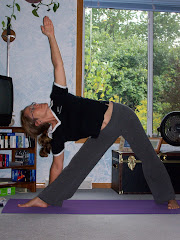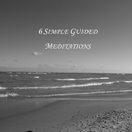"Technically pranayama doesn't mean working with the breath," as a Swami Rama devotee, Nina, reminded me. Pranayama is a Sanskrit term meaning "to extend life force." Depending on how you break up the letters, it could mean "to control life force." I don't think we can completely control life force or Prana; however we can guide it or influence it.
Frequently this yogic technique is simply viewed as breath-work because the easiest means to work with life force is via the breath. As a basis for exploring the breath, it's important to have a foundational understanding of the four stages of breathing. They are as follows:
Inhale - When you emphasize the incoming breath in the chest and then some in the belly it has an energizing and expansive quality. If you mainly breath into the belly, it is calming and can even become depressive over time. On the other hand, only breathing into the chest can bring on anxious feelings and quicken the heart rate. Experiment with these different ways to inhale and find a balance of bringing it from the chest to the belly while stressing the chest and invigorating your body and mind.
Retention - Holding the breath after an inhale has a similar effect to the inhale itself. Use this technique with some caution; if there are any signs of lightheadedness or dizziness, then shorten the pauses or omit altogether. You may notice that when we are shocked, fearful, or horrified the body's tendency is to gasp air in and then hold it. This is NOT the feeling we're going for in pranayama. Instead look for a feeling of gentle expanse, giving the body time to absorb all the oxygen of that breath and for a soft stillness to be experienced.
Exhale - The most natural exhale is a passive one; the abdominals are relaxed and the diaphragm releases upward. This is the most tranquil method of breathing out. It fills the body and mind with surrender, calm, and acceptance. During an asana (posture) practice and for some pranayama techniques the abdominals engage while exhaling. When the abdominals progressively draw in and slightly up, the out breath becomes active and there is a grounding and stabilizing feeling.
Suspension - Pausing after the exhale and not hurrying on to the next in breath, accentuates the effects of the out breath. When this technique is used the body must rely solely on its inner resources. This is one of the reasons to practice hatha yoga; through the postures, focus, and breath-work, the prana storage within the body grows enabling longer suspension of breath and providing greater health and vitality. If your body experiences asthma conditions, it is advised to avoid long suspensions and focus more on the out breath. This is a pretty safe part of the breath; because if you really need to inhale, the body will do just that. According to Gary Kraftsow this phase of the breath cycle "can bring up repressed emotions [and memories].... That is why [he] likes to call this technique the 'open secret of pranayama.'" (Pg 114 Yoga for Transformation) A peaceful suspension of breath is one of the best ways to know the stillness that is always part of you, even when life seems chaotic.
Best of luck exploring!
Kris
www.TotalHealthYoga.com
Today is the first day of the rest of your life!
Tuesday, January 13, 2009
Subscribe to:
Post Comments (Atom)



1 comment:
Post a Comment